Rating of the best kitchen knives

Despite the popularity of kitchen knife sets, most of the work is usually done using only one, maximum two. When buying, you need to focus on the type of material, quality and other features of the product. There are models that occupy leading positions in the ranking, and you should pay attention to them first of all.
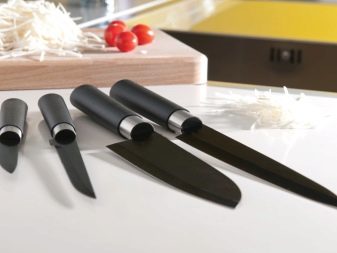
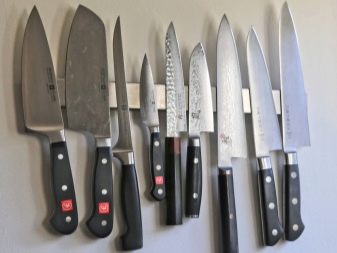
Top steel knives
The best steel kitchen knives for the kitchen are not only beautiful but also convenient. When choosing a professional model or appliance for the home, you should rely on both the manufacturer and the type of steel used.
- Crucible. Manufactured from CPM-S90V steel. Possesses unique corrosion resistance. Such a knife sharpens very quickly, holds the edge perfectly. It is not often found on the market.
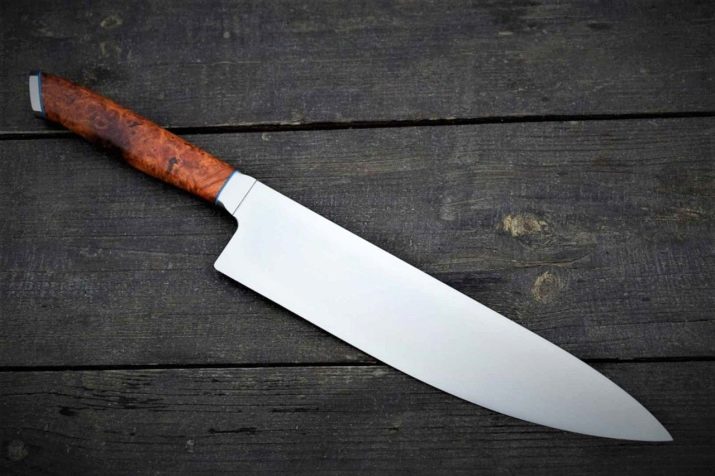
- Viking 940-1. Manufactured from steel of the same type. It is characterized by increased wear resistance. The percentage of carbon in the metal is very high, but the secret lies not in this, but in the high content of vanadium. In this brand it is almost 3 times more than in Elmax. Such knives are expensive, but they are worthy of their price.
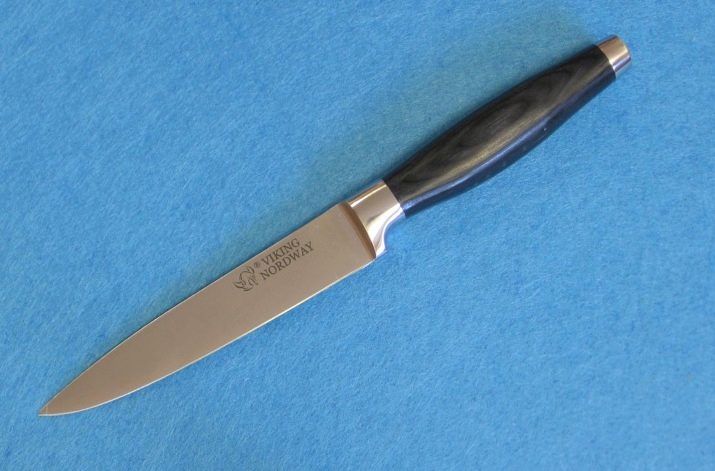
- Benchmade 581. Manufactured from M390 steel. The knife was the result of the merger of the Austrian Bohler and the Swedish Uddeholm. A special powder is applied to the surface, which guarantees excellent corrosion resistance and provides the required hardness. The composition contains metals such as chromium, molybdenum, vanadium and tungsten, which increase the resistance of the edges to bending. Steel can be polished to the point that the knife becomes a mirror.
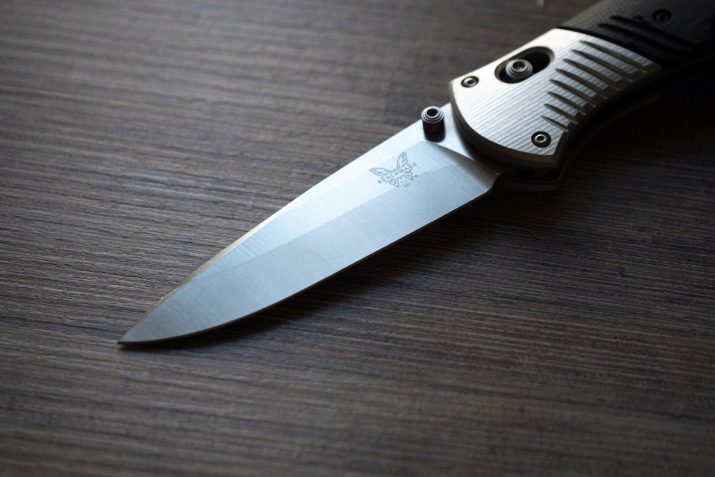
- ZDP-189 "Hitachi"... The knives are made of special steel, which contains a large amount of carbon. The hardness level is 64 HRC, although some manufacturers show a figure of 66 HRC.Sharpening problems can occur even though the edges hold well and retain their shape. With a chromium content of around 20%, one would expect the knife to be immune to corrosion, but this is not entirely true.

- M390 Bohler. Will delight you with a steel blade made of CPM-20CV material. Not a bad knife, which is highly durable, resistant to corrosion.

- European Uddeholm. Made of steel with a lot of carbon. Product introduced by Elmax, which markets high-chromium molybdenum alloy steel products with extremely high wear resistance. One of the advantages is that even after many years of use, corrosion does not form on the surface of a kitchen knife. The product stays sharp for a long time, ideal for professionals. Such knives do not require regular sharpening, as they perfectly hold the edge.
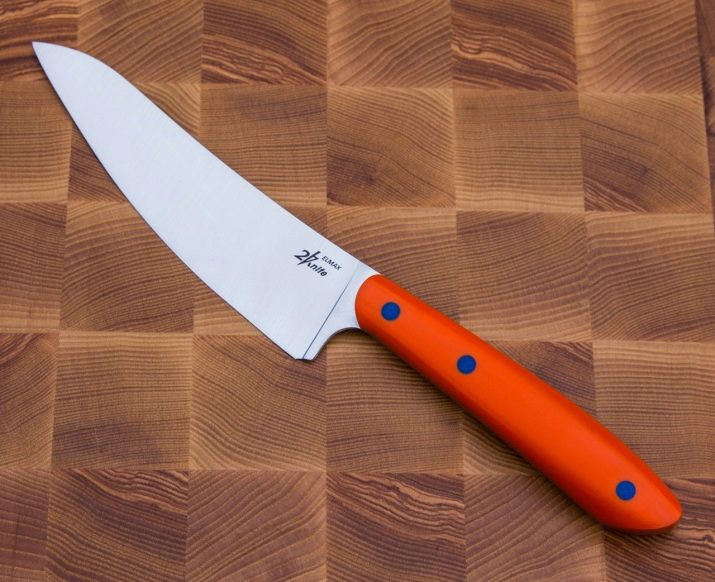
Rating of ceramic products
Ceramic products have recently begun to conquer the hearts of chefs, and all because this material does an excellent job with the task. More and more companies are appearing on the market offering quality knives. There are worthy representatives of Russian production for professionals, including many budget models, and foreign sets for amateurs.
It is possible to distinguish ceramic products intended for domestic and professional use not only by cost, but also by the quality of the material, the need for sharpening. Among the manufacturers making worthy models that have already won the attention of the consumer, the following brands can be distinguished.


Chefcoo
A brand that brings to the attention of the consumer a whole range of knives. The set, in addition to the professional device for the chef, includes knives:
- for pizza;
- for cheese;
- for bread;
- chopping;
- for cleaning vegetables.
Any housewife will be happy to see such a product in her kitchen. Each piece in this set is crafted from stainless steel and has a ceramic coating for added durability.

Benefits:
- each knife is well sharpened;
- the design provides ergonomic handles, so your hands do not get tired, even when you have to cook a lot of food;
- the surface of the handle does not slip - even if the hand is wet, the grip remains firm.
- each knife is color-coded;
- the set includes a magnetic holder on which you can easily store products;
- sharpener included in the set.
Of the shortcomings, only two subjective remarks can be noted:
- the knives are very sharp, you need to work very carefully;
- not everyone likes this design.

Cuisinart Advantage
The Cuisinart name should be familiar to anyone who has ever bought kitchen appliances as the brand offers some of the best products. There is also a set of 12 ceramic knives in their assortment, which are highly resistant to rust.
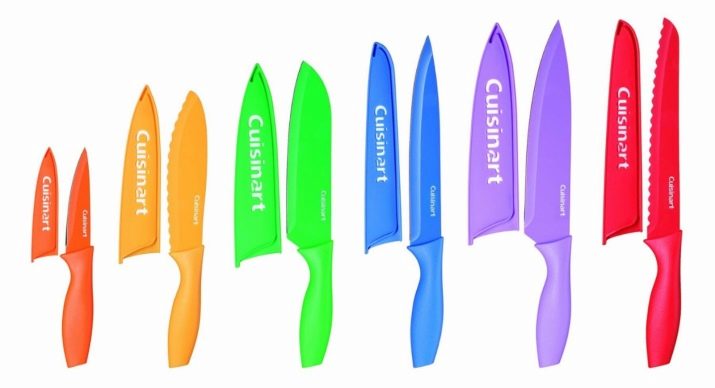
Benefits:
- products have sharp blades that allow you to quickly cut through soft flesh;
- the ergonomic handle is comfortable and relieves pressure on the hands;
- blade guards make knives safer;
- the set contains everything you need to prepare different dishes.
Disadvantages:
- the color coating of the knives wears out after a while;
- blades dull quickly with frequent use.

Checkered Chef 4-Piece
This ceramic knife set contains four knives (3 ", 4", 5 "and 6") that are included with an emphasis on versatility. Each piece has a sharp blade coated with zirconium oxide. The composition is resistant to rust and bacteria.
These knives are also among the lightest when compared to models from other manufacturers. They can be used to prepare various types of food.
The products have a comfortable ergonomic handle.
One of the most notable features is the special handle design to keep the blade from sticking out. This superior feature contributes to improved safety, which is essential when using sharp blades.

Benefits:
- ideal for those chefs who do not want to waste time on additional sharpening;
- the blades are bacteria resistant and will not contaminate food;
- the special design of the handle provides full protection of the fingers from cuts;
- the knife holder is stylish and well thought out - each knife fits perfectly into the slot;
- a pair of stainless steel scissors included.
Among the disadvantages is the need to provide the product with appropriate care.


Oliver & Kline
All knives in the set are equipped with a black handle and quality blades. It doesn't matter who picks up the product - a beginner or a chef, everyone can appreciate its benefits. The vegetable peeler is suitable for cutting fruits.
The blade has excellent long-lasting sharpness. The fact that they do not corrode or rust is another advantage of this manufacturer.

Advantages:
- have an ergonomic handle;
- all knives are universal;
- ceramic knives, when stored properly, are more durable than steel knives.
Disadvantages:
- these knives cannot self-clean, so you have to wash them by hand;
- additionally you need to purchase a storage stand.

MioChef Ceramic
The blades retain their sharpness for many years. The devices are universal. Knives easily cut meat, fruits, vegetables. The set is equipped with lightweight ergonomic handles, so they are comfortable to use.
Advantages:
- extremely sharp blades;
- ceramic blades do not collect bacteria;
- low weight of products;
- the appliances are well balanced.
Of the shortcomings, only too bold design and excessive sharpness can be distinguished. Cutting yourself is very easy, so be careful when working in the kitchen.

Titanium Product Overview
Titanium knives are just as popular as ceramic knives. They are of high quality, most of the models are universal. Professional chefs prefer to choose brands that are in demand in the world for work, since their quality and reliability have been proven more than once. The rating of standing products includes the following sets.
- Clauss 18417. The titanium blade is the first in its class. Reduced weight and dishwasher safe. The material is highly resistant to corrosion. The manufacturer paid special attention to the dimensions of the product, so the knife has an ideal design.

- High Quality. It is characterized by unsurpassed quality. This is a set of 6 knives made of titanium stainless steel. Comes with a magnetic holder for convenience and ease of use. Can be hung over a stove or work area for easy access. Knives easily cope with meat, vegetables. The ergonomic handle allows a beginner chef to use the product.


- Hampton Forge. A standing set of 10. The model has an original design, each knife has sharp blades and an ergonomic handle. The knives have special cut guards.


- Chef's Star: A premium set from leading home appliance company Chef's Star saves time and energy when preparing food. The set contains 6 products and a special block for their storage. The handles are slip-resistant and ergonomic, so the chef feels comfortable while working.

- SiliSlick. Has a special titanium coating. The knives are easy to work with and are perfectly balanced, thus reducing the stress on the wrist. Even after repeated use, sharpening will not be required soon.


How to choose?
People who are just comprehending the art of culinary sometimes do not know how to choose a quality knife so that it is convenient for them to work, and the product itself meets the necessary requirements. Before purchasing a kitchen knife, it is important to consider the following factors:
- the type and type of knife, taking into account the dishes that are planned to be cooked;
- the size of the product so that you can use it without additional stress on the hand;
- the material from which the blade is to be made;
- how much money a chef is willing to pay for a good knife.
The basic design of a kitchen knife has not undergone major changes over the past 10,000 years, so it remains a product with a blade and handle. But in the area of the materials used (especially steel) and their processing, great progress has been made.




The quality and price of a kitchen knife is currently determined by:
- quality of steel;
- a way of turning steel into a blade and hardening;
- how sharp the blade is and how long it stays sharp;
- how often you need to sharpen the knife;
- balance between blade and handle;
- the quality of the handle.
A kitchen knife is an indispensable tool with two main features: functionality and ergonomics. The wider the blade, the better it is for cutting vegetables and fruits, but not for general kitchen tasks. Narrow blades are used by professionals for cutting raw meat or fish and are not suitable for quick chopping.


Appointment
If you want a multi-purpose knife - Gyuto (Chef's knife) or Bunka are great choices. If the chef prefers a shorter type of blade, then the knives Santoku fit perfectly... Good models are Nakiri and Usuba. For processing large pieces of meat and fish, it is worth using products Yanagiba, Sujihiki and the broader Gyuto.




In a simple, no-force cutting process, sharpness is key to kitchen knives. These products are usually thinner and more sensitive, and therefore cannot be used for complex tasks such as cutting bones, slicing fish (filleting) or opening a coconut.
This requires a correspondingly thicker kitchen knife such as the Deba or the heavier Cleaver.


Hardness of steel
Most modern kitchen knives made from stainless steel do not retain the desired sharpness for a long time because the blades are not hardened or processed using steel hardening methods. HRC or Rockwell scale is currently the best way to determine the hardness of steel. 56 HRC is the lowest level of hardness. Such a product will not only become dull soon, but it is not so easy to sharpen it.
Kitchen knives that are labeled “stainless” have a very high chromium (Cr) and low carbon (C) content and are therefore not a good choice for professional use, but are suitable for the home.
If you need a better product, then you should choose a knife that has a blade with a lower level of chromium and added vanadium or molybdenum, which has been hardened to at least 56 HRC.


If it is not possible to find data on the type, quality and hardness of the steel when buying a knife, then it is usually stainless steel with a high chromium content and too low carbon content.
Steel with a high carbon content (C> 0.8%) remains sharp for a longer period of time, it is easier to sharpen, but patina appears on the blade because the required amount of chromium is not in the composition. Stainless steels with a high carbon and chromium content (Cr> 10%) remain sharp for a long period of time, but are slightly more difficult to sharpen.
It is best when the model is made of tool steel, which has a high carbon content, but is difficult to cut. The sharpness of such models persists for a long time.

Combined steel and grinding angle
The blades of rolled steel kitchen knives are made from two or more different types of steel. Usually the core is made of a very hard, quality material that is coated with a softer, stainless steel layer.
The advantage of such products is that thanks to the hard core, they stay sharp for a very long period of time, and thanks to the softer outer layer, they are easier to sharpen. Softer outer layers protect the core from external factors. If rust, which usually appears on the tip of the blade, forms, you can easily grind off this area.
Kitchen knives, which are of different types of steel, have a special look. Their folded layers look like growth rings, this pattern is called "damascus". Damascus patterns make each knife unique, but do not add any improved performance to the blade.
Beautiful examples of damask patterned knives are Santoku 3D by Shikegi Tanaka or Santoku Wa.


A classic German or French kitchen knife is ground on both sides of the blade, usually at the same angle of about 20-30 degrees. This type of equipment has a not too sensitive edge and is suitable for both left-handed and right-handed people.
Japanese products such as Gyuto, Santoku are sharpened at a smaller angle, between 12 and 18 degrees, and very often the center of the edge shifts slightly to the left or right (for example, in a 70/30 ratio). This species is much sharper, but at the same time much more sensitive to shock, chipping or rough use. Moving the center of the edge to one side makes the knife suitable for left-handed or right-handed use.
Traditional Japanese knives are ground only on one side. A long, flat bevel of about 12 degrees is made on one side, with a slightly concave surface on the other.
This feature allows you to get a much sharper angle, and, therefore, a higher sharpness of the knife. The tool is easier to reconfigure and at the same time suitable for use by both left-handers and right-handers.


Prices
The average cost of a knife 18 cm long with a simple handle and a decent steel blade starts at about 3,000 rubles. A longer blade includes more steel and therefore increases cost.
A well thought-out and balanced handle adds a few more hundred rubles to the cost. Hand-forged laminated steel kitchen knives with well-designed handles from well-known manufacturers can cost tens of thousands of rubles.

How to choose a good kitchen knife, see below.








